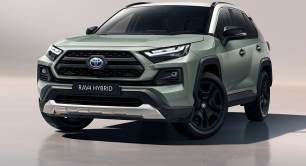Overall, the Tremor is nice to drive on road. It’s quiet, refined and comfortable and the engine and transmission make a cluey, unstressed pairing.
However, the Tremor’s suspension – engineered to improve the vehicle’s off-road capability – is firm through sections of back-country bitumen and even mildly corrugated bush tracks.
Also, this Everest’s all-terrain tyres don’t help ride quality or noise levels on sealed surfaces. But that’s no surprise and a very minor trade-off when the Tremor's potential as a touring vehicle is so high.
On the open highway at cruising speed, the Tremor exhibits all of the smooth-driving characteristics the Everest line-up is well known for.
It sits nicely on the road, that wide wheel track (a 30mm increase in width to 1650mm) gives it a solid stance and this V6 ute simply rumbles along.
So, how does it perform in 4WD territory? Well, it’s based on the Everest Sport, which is no off-road loser, so you’d assume the Tremor would do okay.
However, we all know if you assume, it makes an 'ass' out of 'u' and 'me'… but the Tremor has been engineered to outperform the standard Everest in the dirty stuff. Unsurprising spoiler alert, it does, but only marginally.
The Everest Tremor is 4914mm long (without the towbar hitch receiver; 4978mm with), 2015mm wide (mirrors in; 2207mm, mirrors out) and 1904mm high.
It has a 2900mm wheelbase and a listed kerb weight of 2550kg, the latter making it the heaviest Everest in the line-up.
This is not a diminutive wagon but it has the smallest turning circle (11.65m) in the Everest range and its dimensions don’t hamper it in the bush.
As mentioned earlier, when you add running ground clearance to any off-roader its off-road performance will be improved. The Tremor has more ground clearance (255mm) than its stablemates but, as with any measurements provided by vehicle manufacturers (ground clearance, wading depth, towing capacities, etc), always regard those figures with a healthy degree of scepticism.
Wading depth is listed as 800mm and its off-road angles are in line with market rivals: for your reference, approach, departure and ramp-over angles are listed as 32, 26.8 and 23.9 degrees, respectively.
This wagon’s 3.0-litre turbo-diesel V6 offers plenty of torque across a broad rev range, the 10-speed auto is clever – no flip-flopping between ratios here – and you can use the manual shifter if you get the urge.
Low-range gearing is adequate and the Tremor has an electronic rear diff lock.
The Tremor has a variety of selectable on- and off-road drive modes, including 'Normal', 'Eco', 'Tow/Haul', 'Slippery', 'Mud/Ruts', 'Sand and Rock' and the Tremor-specific 'Rock Crawl' plus a locking rear diff.
These off-road driving modes are no substitute for track-worthy 4WD mechanicals but they help by adjusting engine, throttle, transmission, braking, traction and stability controls to suit the driving conditions.
Off-road traction control is effective without being spectacular. There’s a bit too much wheelspin for my liking.
Off-road applications are displayed on screen – with driveline/diff lock indicators, steering, pitch and roll angles depicted. Hill descent control held the Tremor to a steady 3.0-4.0km/h as I crawled down a difficult slope.
The power steering, light and sporty in all scenarios, has been tweaked with a heavy-duty tune and it retains a confident feel in difficult conditions.
Heavy-duty off-road engineering has bolstered the suspension set-up with new springs and Bilstein dampers with external reservoirs.
Wheel travel – how far the axle can move up and down vertically wheel-to-wheel relative to the chassis – is slightly better than a standard Everest’s, with this wagon’s tyres stretching a little further than the regular version’s.
Again, as I mentioned earlier, by replacing an off-roader’s standard road-biased rubber with a set of decent all-terrain tyres its off-road capability will be improved. And that’s exactly what Ford has done.
The Tremor's General Grabber all-terrain tyres feature light-truck construction. They are grippy and very effective in dirt, loose gravel, slippery clay and the like.
There are a few niggles, though.
I’ve previously expressed annoyance at the auto transmission shifter – a kind of joystick on a light cycle of steroids and just as touchy. It’s especially finicky on bumpy terrain but it’s another Everest-based characteristic to which I’ve become somewhat accustomed.
The operation of some off-road driver-assist tech can be confusing as it’s divided between the rotary dial (to select drive modes) and the screen (to engage the rear diff lock etc). Not a deal-breaker, but it takes some getting used to.
The brake pedal is spongy – taking some time between initial foot pressure to ‘biting', but then the brakes – discs all around – do clamp into action.
As for packability, there is a listed 259 litres (VDA) of space in the rear-most cargo area (with all three rows of seats in use), 898L (VDA) when the third row is stowed away and 1823L (VDA) when the second and third rows are lowered.
The Everest Tremor has a listed payload of 690kg, and towing capacities of 750kg (unbraked) and 3500kg (braked).
It has a listed GVM (Gross Vehicle Mass) of 3240kg and a GCM (Gross Combined Mass) of 6350kg. Remember: any onboard loads – such as people, pets, camping gear or aftermarket equipment (bullbar, roof rack etc) – must figure in your payload and GVM equations.







.png)



























.png)























